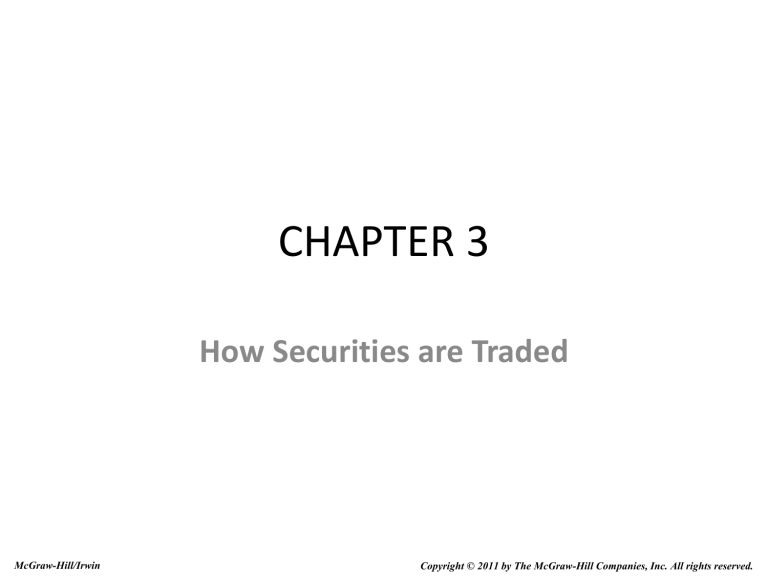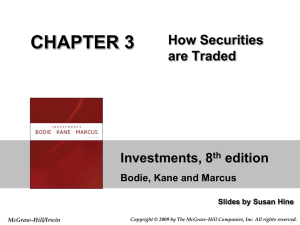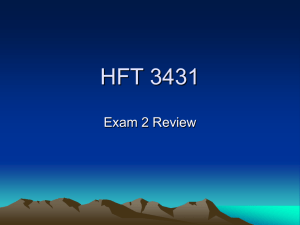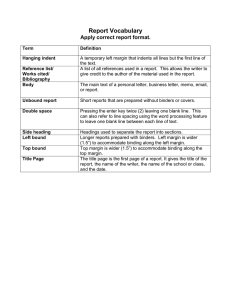How Securities are Traded

McGraw-Hill/Irwin
CHAPTER 3
How Securities are Traded
Copyright © 2011 by The McGraw-Hill Companies, Inc. All rights reserved.
How Firms Issue Securities
• Primary Market
– Firms issue new securities through underwriter to public
– Investors get new securities; firm gets funding
• Secondary Market
– Investors trade previously issued securities among themselves
3-2
How Firms Issue Securities (Ctd.)
• Stocks
– IPO
– Seasoned offering
• Bonds
– Public offering
– Private placement
3-3
Investment Banking
• Underwriting: Investment bank helps the firm to issue and market new securities
• Prospectus: Describes the issue and the prospects of the company.
– Red herring
3-4
Figure 3.1 Relationship Among a Firm Issuing
Securities, the Underwriters, and the Public
3-5
Investment Banking
• Firm commitment
– investment bank purchases securities from the issuing company and then resells them to the public.
• Shelf Registration
– SEC Rule 415: Allows firms to register securities and gradually sell them to the public for two years
3-6
Investment Banking (Ctd.)
• Private placements
– Firm uses underwriter to sell securities to a small group of institutional or wealthy investors.
– Cheaper than public offerings
– Private placements not traded in secondary markets
3-7
Initial Public Offerings
• Process
– Road shows to publicize new offering
– Bookbuilding to determine demand for the new issue
– Degree of investor interest in the new offering provides valuable pricing information
3-8
How Securities are Traded
Types of Markets:
• Direct search
– Buyers and sellers seek each other
• Brokered markets
– Brokers search out buyers and sellers
3-9
How Securities are Traded
Types of Markets:
• Dealer markets
– Dealers have inventories of assets from which they buy and sell
• Auction markets
– traders converge at one place to trade
3-10
Bid and Asked Prices
Bid Price
• Bids are offers to buy.
• In dealer markets, the bid price is the price at which the dealer is willing to buy.
• Investors “sell to the bid”.
• Bid-Asked spread is the profit for making a market in a security.
Ask Price
• Asked prices represent offers to sell.
• In dealer markets, the asked price is the price at which the dealer is willing to sell.
• Investors must pay the asked price to buy the security.
3-11
Types of Orders
• Market Order: Executed immediately
– Trader receives current market price
• Price-contingent Order:
– Traders specify buying or selling price
• A large order may be filled at multiple prices
3-12
Figure 3.5 Price-Contingent Orders
3-13
Trading Mechanisms
• Dealer markets
• Electronic communication networks
(ECNs)
– True trading systems that can automatically execute orders
• Specialists markets
– maintain a “fair and orderly market”
3-14
Trading Costs
1. Brokerage Commission: fee paid to broker for making the transaction
– Explicit cost of trading
– Full Service vs. Discount brokerage
2. Spread: Difference between the bid and asked prices
– Implicit cost of trading
3-15
Buying on Margin
• Borrowing part of the total purchase price of a position using a loan from a broker.
• Investor contributes the remaining portion.
• Margin refers to the percentage or amount contributed by the investor.
• You profit when the stock appreciates.
3-16
Buying on Margin (Ctd.)
• Initial margin is set by the Fed
– Currently 50%
• Maintenance margin
– Minimum equity that must be kept in the margin account
– Margin call if value of securities falls too much
3-17
Margin Trading:
Initial Conditions Example 3.1
Share price $100
60%
40%
100
Initial Margin
Maintenance Margin
Shares Purchased
Initial Position
Stock $10,000 Borrowed $4,000
Equity $6,000
3-18
Maintenance Margin Example 3.1
Stock price falls to $70 per share
New Position
Stock $7,000 Borrowed $4,000
Equity $3,000
Margin% = $3,000/$7,000 = 43%
3-19
Margin Call Example 3.2
How far can the stock price fall before a margin call? Let maintenance margin = 30%
Equity = 100P - $4000
Percentage margin = (100P - $4,000) / 100P
(100P - $4,000) / 100P = 0.30
Solve to find:
P = $57.14
3-20
Table 3.4 Illustration of Buying Stock on Margin
3-21
Short Sales
• Purpose: to profit from a decline in the price of a stock or security
• Mechanics
– Borrow stock through a dealer
– Sell it and deposit proceeds and margin in an account
– Closing out the position: buy the stock and return to the party from which it was borrowed
3-22
Short Sale:
Initial Conditions Example 3.3
Dot Bomb 1000 Shares
50%
30%
$100
Initial Margin
Maintenance Margin
Initial Price
Sale Proceeds $100,000
Margin & Equity $50,000
Stock Owed 1000 shares
3-23
Example 3.3 (Ctd.)
Dot Bomb falls to $70 per share
Assets
$100,000 (sale proceeds)
$50,000 (initial margin)
Liabilities
$70,000 (buy shares)
Equity
$80,000
Profit = ending equity – beginning equity
= $80,000 - $50,000 = $30,000
= decline in share price x number of shares sold short
3-24
Short Sale - Margin Call
How much can the stock price rise before a margin call?
($150,000 * - 1000P) / (1000P) = 30%
P = $115.38
* Initial margin plus sale proceeds
3-25
Insider Trading
• Officers, directors, major stockholders must report all transactions in firm’s stock
• Insiders do exploit their knowledge
– Jaffe study:
– Inside buyers>inside sellers = stock does well
– Inside sellers>inside buyers = stock does poorly
3-26








